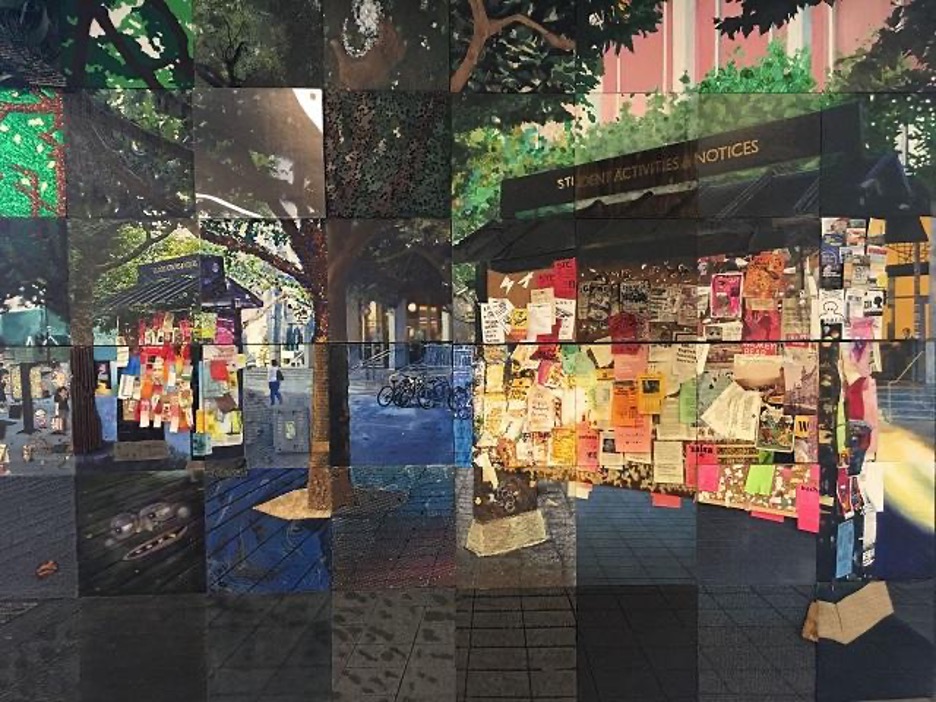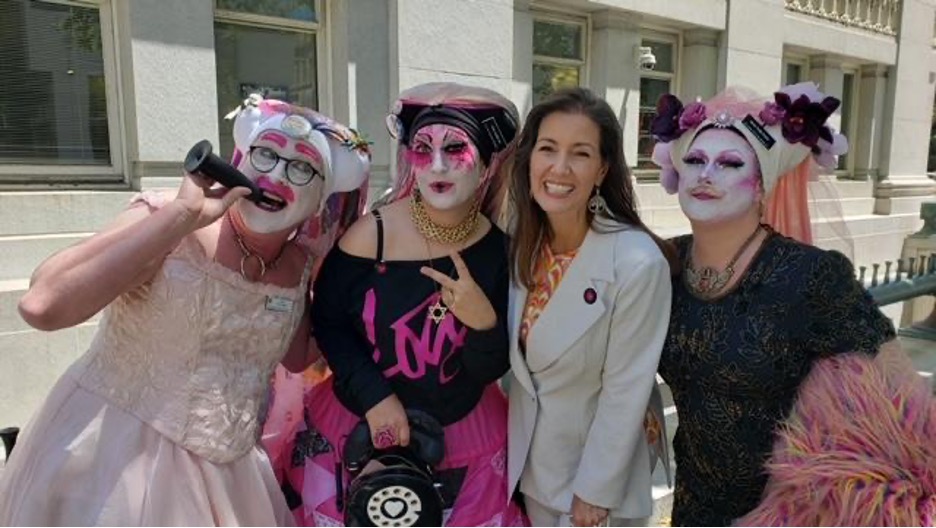This month’s volunteer spotlight is shining on ISSTD Board Member, Katie Keech.
EC: Can you tell us about where you live?

KK: I grew up in Los Angeles, but I live and work in Oakland presently. It has been a phenomenal city to immerse oneself in. People are often afraid of my area (West Oakland), but it’s the tightest neighborhood community I’ve ever experienced – even if it doesn’t look the prettiest. For instance, we have a community market in an old industrial area on Magnolia Street that has a Thai coffee place, and a small market to buy local duck and chicken eggs as well as honey. Next to it there’s brick oven pizza, there’s a place to buy herbs, and another place that serves fresh Korean noodles made on the spot. But if you walked by it, you’d likely think it’s a junkyard and not go in. I know almost all my immediate neighbors. And that includes many unhoused neighbors that I have worked with through various community mental health organizations I have worked for over the years.
EC: What is your educational and professional background?
KK: I started out in the arts. I started focusing on life sculpture for years but found I had more of an aptitude for oil painting, mostly at the insistence of an artist named Wendy Sussman who took me under her wing briefly. I focused on expressionist portraits, in part, because I love taking color, line, and raw energy that should look abstract and shaping it into an emotionally charged image of a person caught in a specific moment.

I failed statistics the first time that I took it and that kind of pushed me out of my direction for art as a career. I was on a temp admit to Cal Berkely and the statistics grade did not allow me to continue. I was accepted to UC Riverside after that, but I just couldn’t imagine moving there. And SF State would not accept years of previous art classes which would make graduating with an art degree take a really, really, long time. I had to re-evaluate what I wanted to focus on and psychology seemed to be a natural second option.
EC: What is something about yourself that most people don’t know?
KK: I’m still involved in the arts. While I don’t make money in it, I’ve managed to collaborate with other phenomenal artists on larger scale artwork which has had the fortune to be shown in different places across the United States. Most of this has been through an art collective that I belong to called Five Ton Crane. We have done large scale collaborative paintings that have hung outside the SF MOMA in their parking garage and one permanently hangs in a library in UC Berkeley. So, even though I did not graduate from there, they are displaying a painting of mine. I’ve helped to create a large rocket ship that was displayed on the SF docks for months, some details for a huge granny boot house you can walk through with several stories (pun intended), and most recently my partner and I designed the theater candy that went into a 1929 silent movie house which was shown in the Smithsonian Renwick Gallery, The Cincinnati Museum of Art and the Oakland Museum of Art. You can click here to see.

EC: What has been the most challenging experience of your career? And what has been the best?
KK: I suppose the closest thing I can say to answer that is that I never intended to be as involved in community mental health as long I ended up being in it. I thought I would slip into private practice at several different points, but that’s certainly not what happened. It wasn’t all bad, though. I would have never had the extreme immersion into community mental health that I have if it were not for all those errors. I ended up with an increased passion for providing real and meaningful assistance to our communities and those that do not have the funds to afford the help that they truly deserve as members of our society. And I learned that I have an aptitude for managing complicated mental health programs, harnessing a team, and meeting expected targets. This gave me a sense of pride in myself.
But community mental health is a complicated machine that often runs on a deficit. It generally expects well-meaning and good-hearted individuals to shore up that deficit by working longer and harder. And I certainly did that for quite a while until I found I had sacrificed too much of my own life to maintain my own sanity and health.
I’m a pretty involved program manager and supervisor. Many of these individuals on the caseloads of those I supervise have been direct clients of mine in the past, so I know them well. And I have also involved myself with the newer clinicians on my teams as a direct mentor, going out to meet with them to assist them in performing their clinical work with clients in the community and helping directly when a crisis arose. So even though there were about 110 clients to track across the two programs I managed, a good chunk of those clients had direct relationships with me.
And because of the length of time I had been involved in community mental health and the oversight of so many clients, I experienced quite a bit of loss over the years as well as episodes of intense crisis management which sped up during the first year of the pandemic. Fortunately, there were no recent losses to suicide. I actually created some changes in how the program I oversaw was run that reduced the need to utilize hospitalizations and decreased some suicidality even in the face of the pandemic. But there were some losses due to homicide during my last year in CMH.
Losses aren’t isolated. And losses don’t get easier. They start to stack up on each other emotionally so that each fresh loss isn’t just that one loss. It’s all of the other losses combined standing in front of you, shoulder to shoulder, with the new one.
EC: How did you first learn about dissociation?
KK: I first heard about it when I was 21 through a comic called Cuckoo. That was the same time as my being booted from Berkeley for failing stats and I was using art comics as a form of coping. It was created by a young woman who experienced dissociative identity disorder and she drew these amazing comics about it. I still have all of the comics from her series. It’s extremely brilliant.
But I’d been managing issues with dissociation myself, and really, I had no idea what was going on until I read that comic. I couldn’t even get glasses that worked for me as a kid because my eyes wouldn’t focus during eye exams due to my derealization and anxiety. While I didn’t have the level of dissociation depicted in the comic, it helped me to understand my CPTSD and start work to heal it.

And, then, I started to have clients that were showing up in my practicum that had high levels of dissociation but had not been correctly diagnosed. I understood what it was, but I did not know how to help someone through the steps of getting better. Unfortunately, neither did my assigned supervisors at the time. And because I was recognizing it, I was also suddenly getting direct referral from individuals with dissociation who needed a therapist that would take five bucks a session who also at least understood what dissociation was. Since I did not want to refer out the clients I had because I had a good connection with them, I sought out supplementary supervision from people who did have experience.
EC: How did you discover the ISSTD?
KK: Eventually was assigned a supervisor who had experience with dissociative disorders which made a big difference, and that was how I first learned about ISSTD.
Even though I was an intern, I got a recommendation to attend an initial class. I joined specifically to attend that class. I think it was the prototype for the current PTP class on trauma we have now, with Dr. Steven Frankle as the assigned teacher. I do remember it being the first one of its kind and sort of being floated as a new thing that was being attempted. It felt really wild because I was this late 20 something hanging out with these seasoned clinicians in Steven Frankle’s office in Walnut Creek month after month who already seemed to know all the stuff I was trying to learn, but they were all really supportive and helpful. It made a huge difference in my clinical work even though it was just the start.
For volunteering, I have helped the ISSTD on the Rapid Response Team, the Public Health Committee, Finance Committee, and Fundraising Committee. I am currently the Secretary for the Board and Executive Committee. I am also on the Guidelines Revision Task Force to provide feedback in the area of teens and LGBTQ perspectives, as well as for the Transitional Aged Youth/Emerging Adults. I helped create the Transitional Aged Youth SIG, and more recently helped create the new Transgender and Non-Binary SIG, and serve as Chair.

